Study on the Spatial Structure of the Complex Network of Population Migration in the Poyang Lake Urban Agglomeration
Abstract
:1. Introduction
2. Materials and Methods
2.1. Research Object
2.2. Data Source and Description
2.3. Study Time and Total Data
2.4. Research Methods
2.4.1. Edge Weight
2.4.2. Network Density
2.4.3. Degree of Centralization
2.4.4. Network Structure Entropy
3. Results
3.1. Analysis of the Characteristics of Complex Network Indicators of Population Migration in the Poyang Lake Urban Agglomeration
3.1.1. Edge Weight
3.1.2. Network Density
3.1.3. Degree of Centralization and Network Structure Entropy
3.2. Analysis of Spatial Structure Characteristics of the Complex Network of Population Migration in the Poyang Lake Urban Agglomeration
3.2.1. Spatial Structure of the First Weighted Population Migration Network
- Analysis of the characteristics of the first weighted migration axis of immigration
 ” pattern which is presented as a bow and arrow with an opening to the northwest in most of the remaining months. The network of migration axes within the urban agglomerations is more intensive than that of external migration.
” pattern which is presented as a bow and arrow with an opening to the northwest in most of the remaining months. The network of migration axes within the urban agglomerations is more intensive than that of external migration.- 2.
- Analysis of the characteristics of the first weighted migration axis of emigration
 ” with an obtuse angle opening to the northwest. ➁ Internal Migration Patterns: In the context of internal migration, the density of axial connections among nodes within the urban agglomerations remains relatively low. However, it is slightly denser compared to external migration.
” with an obtuse angle opening to the northwest. ➁ Internal Migration Patterns: In the context of internal migration, the density of axial connections among nodes within the urban agglomerations remains relatively low. However, it is slightly denser compared to external migration.3.2.2. Spatial Network Topology Feature Analysis
- Analysis of the topological structure of the Spatial Network of the immigration
 ” pattern which exhibits a pentagonal snowflake-shaped antennal dispersion morphology; ➁ the rest of the axes show: a tentacle dispersal spatial network pattern; ➂ the overall spatial structure forms a “
” pattern which exhibits a pentagonal snowflake-shaped antennal dispersion morphology; ➁ the rest of the axes show: a tentacle dispersal spatial network pattern; ➂ the overall spatial structure forms a “ + tentacle dispersal” shaped spatial network pattern.
+ tentacle dispersal” shaped spatial network pattern. - 2.
- Analysis of the topological structure of the spatial network of the emigration
 ” as the main feature, but the north and southwest directions are the main migratory axial belt; ➁ the migratory axes in the rest of the directions are weaker, forming a weak tentacle dispersal-like spatial network pattern; ➂ the overall spatial structure forms a “
” as the main feature, but the north and southwest directions are the main migratory axial belt; ➁ the migratory axes in the rest of the directions are weaker, forming a weak tentacle dispersal-like spatial network pattern; ➂ the overall spatial structure forms a “ + weak tentacle dispersal” shaped spatial network pattern.
+ weak tentacle dispersal” shaped spatial network pattern.4. Discussion
4.1. Exploration of Complex Network Characteristics of Urban Agglomerations
4.2. Characterization of the Spatial Structure of Urban Agglomeration
4.2.1. Impact of First Weighted Population Migration on Urban Agglomeration
4.2.2. Exploration of Spatial Network Topology
4.3. Recommendations for Optimizing the Network and Spatial Structure of Urban Agglomeration
4.4. Directions for Future Research
5. Conclusions
Author Contributions
Funding
Institutional Review Board Statement
Informed Consent Statement
Data Availability Statement
Conflicts of Interest
References
- Gottmann, J. Megalopolis or the Urbanization of the Northeastern Seaboard of the US. Econ. Geogr. 1957, 33, 189–200. [Google Scholar] [CrossRef]
- Fang, C. Progress and the future direction of research into urban agglomeration in China. Acta Geogr. Sin. 2014, 69, 1130–1144. [Google Scholar]
- Deng, H.; Li, H. Identification of Urban Spatial Structure of Pearl River Delta Urban Agglomeration Based on Multisource Spatial Data. J. Urban Plan. Dev. 2023, 149, 05023010. [Google Scholar] [CrossRef]
- Cao, W.; Dong, L.; Cheng, Y.; Wu, L.; Guo, Q. Constructing multi-level urban clusters based on population distributions and interactions. Comput. Environ. Comput. Environ. Urban Syst. 2023, 99, 101897. [Google Scholar] [CrossRef]
- Wang, X.; Zhao, Z.; Cao, W.; Wang, S. The network characteristics and provincial boundary effect of urban agglomerations in the Yangtze River Delta Based on the perspective of population mobility. Geogr. Res. 2021, 40, 1621–1636. [Google Scholar]
- Zhang, W.; Hao, Z.; Wang, Y.; Wei, R. Spatial network and influencing factors of population mobility in urban agglomeration. Geoscience 2023, 43, 72–81. [Google Scholar]
- Hou, L.; Sun, J. Evaluation of network structure resilience of Chengdu-Chongqing urban agglomeration from the perspective of complex networks. World Reg. Stud. 2022, 31, 561–571. [Google Scholar]
- Zhang, X.; Han, H.; Tang, Y.; Luo, G. Research on the characteristics of urban network structure in China based on Baidu migration data. J. Geo-Inf. Sci. 2021, 23, 1798–1808. [Google Scholar]
- Yue, H.; Qi, J.; Chen, Y.; Chen, L.; Chen, H. Centrality and symmetry analysis of network structure of three major urban agglomerations in China based on Baidu migration data. Surv. Mapp. Bull. 2022, 110–116. [Google Scholar]
- Fan, Y.; Ma, W. Analysis of the spatial network structure of Beijing-Tianjin-Hebei urban agglomeration based on economic correlation. Reg. Econ. 2022, 13, 162–165. [Google Scholar]
- Huang, F.; Yang, T. Spatial connectivity and social network of Pearl River Delta cities—An analysis based on “flow space”. Trop. Geogr. 2022, 42, 9. [Google Scholar]
- Ma, S.; Wu, Y.; Chen, X. Structural Resilience Analysis of Multimodal Transportation Networks in Urban Agglomeration: A Case Study of Guanzhong Plain Urban Agglomeration. J. Tsinghua Univ. (Nat. Sci. Ed.) 2022, 62, 1228–1235. [Google Scholar]
- Wang, W.; Yan, X. Research on the evaluation of smart urban agglomeration development based on entropy weight method. Ind. Appl. 2022, 11, 61–72. [Google Scholar]
- Chakraborty, S.; Maity, I.; Patel, P.; Dadashpoor, H.; Pramanik, S. Spatio-temporal patterns of urbanization in the Kolkata Urban Agglomeration: A dynamic spatial territory-based approach. Sustain. Cities Soc. 2021, 67, 102715, republished. [Google Scholar] [CrossRef]
- Asogwa, F.; Amuka, J.; Igwe, A.; Nkalu, C. Dynamics of population, urban agglomeration, and economic growths in Sub-Saharan Africa: Evidence from panel data. J. Public Aff. 2020, 22, e2447. [Google Scholar] [CrossRef]
- Lv, K.; He, Y. Economic agglomeration, technological progress, and carbon emission intensity in the Yangtze River Delta urban agglomeration empirical study based on spatial measurement and mediating effects. Ecol. Econ. 2021, 37, 13–20. [Google Scholar]
- Zeng, P.; Pang, Y.F. Regional differences and convergence analysis of economic development of Chinese urban agglomeration. Econ. Empirics 2023, 17, 132–136. [Google Scholar]
- Bureau of Statistics of the People’s Republic of China. China Statistical Yearbook; China Statistics Press: Beijing, China, 2018.
- Jiangxi Provincial Bureau of Statistics; National Bureau of Statistics; Jiangxi Survey Team. Jiangxi Statistical Yearbook; Jiangxi Provincial Bureau of Statistics: Nanchang, China, 2019.
- Guo, S.; Lu, Z. Fundamental Theory of Complex Network; Science Press: Beijing, China, 2016. [Google Scholar]
- Wang, X.; Gao, X. The Evolution of China’s Floating Population and Its Impact on Urbanization: A Comparative Analysis Based on Inter- and Intra-Provincial Perspectives. Sci. Geogr. Sin. 2019, 39, 1866–1874. [Google Scholar]
- Niu, X.; Zhu, Y. Spatial Patterns of Population Urbanization in China under the Perspective of Population Migration—A Study Based on Baidu Migration Data. Urban Plan. 2023, 1–10. [Google Scholar]
- Zheng, B.; Zhong, Y. Study on Spatial Structure of Population Migration Network of Urban Agglomeration in the Middle Yangtze River Based on Complex Network. Econ. Geogr. 2020, 40, 118–128. [Google Scholar]
- He, X.; Chen, X. Influence and spatial effect of population mobility on regional innovation capacity-example of 70 cities in three major urban agglomeration of Yangtze River Economic Belt. West. Forum 2023, 33, 109–124. [Google Scholar]
- People’s Government of Jiangxi Province. Available online: http://www.jiangxi.gov.cn/col/col424/index.html (accessed on 5 October 2023).
- People’s Government of Hunan Province. Available online: http://www.hunan.gov.cn/zfsj/tjnj/tygl.html (accessed on 5 October 2023).
- Hubei Provincial Statistics Bureau. Available online: https://tjj.hubei.gov.cn/tjsj/ (accessed on 5 October 2023).
- Guo, W.; Zhong, Y.; Fu, Y. Comparison of economic linkage capacity of urban agglomeration in the middle reaches of Yangtze River. J. South China Norm. Univ. (Nat. Sci. Ed.) 2019, 51, 79–87. [Google Scholar]
- Wang, S.; Song, Y.; Zhang, Y.; Li, J. Spatial association mechanism of urban network in the middle reaches of Yangtze River urban agglomeration under the perspective of transport cost. Econ. Geogr. 2020, 40, 87–97. [Google Scholar]
- Chen, B.; Peng, W.; Liu, Y. Spatio-temporal evolution and driving factors of green innovation efficiency in urban agglomeration in the middle reaches of the Yangtze River. Econ. Geogr. 2022, 42, 43–49. [Google Scholar]
- Dan, J.; Yin, J. Migration Distance of Floating Population and Regional Differences of Its Influence on Urbanization. Acta Sci. Nat. Univ. Pekin. 2017, 53, 487–496. [Google Scholar]
- Zhang, H. Impacts of Statistical Belonging of Floating Population on Urbanization Level. City Plan. Rev. 2018, 42, 17–24. [Google Scholar]
- Ma, Z.; Zhang, S.; Zhao, S. Study on the Spatial Pattern of Migration Population in Egypt and Its Flow Field Characteristics from the Perspective of “Source-Flow-Sink”. Sustainability 2021, 13, 350. [Google Scholar] [CrossRef]
- Zhao, S.; Wang, X.; Ma, Z. Study on Fractal Characteristics of Migration-Population Flow—Evidence from Egypt. ISPRS Int. J. Geo-Inf. 2021, 10, 45. [Google Scholar] [CrossRef]
- Wang, Y. Research on the characteristics of spatial network structure of urban agglomeration in Yangtze River Delta. Stat. Obs. 2022, 6, 69–73. [Google Scholar]
- Niu, F.; Liu, W.; Song, T.; Hu, Z. A multi-level spatial structure analysis algorithm for urban agglomeration study in China. Geogr. Res. 2015, 34, 1447–1460. [Google Scholar]
- Zhao, M.; Lai, Z.; Zhong, Y.; Derudder, B. Polycentric network topology of urban agglomerations in China. Adv. Geogr. Sci. 2016, 35, 376–388. [Google Scholar]
- Liu, X.; Liu, H.; Zou, B.; Jin, Y.; Yi, Y.; Wang, J. Comparison of hierarchical structure of urban agglomeration based on urban linkage network. Econ. Geogr. 2021, 41, 55–61+91. [Google Scholar]
- Wang, R.; He, W.; Lu, C. Study on the Network Structure Characteristics of Three National-level Urban Agglomerations and Their Hierarchical Linkages. J. Hunan Univ. Technol. 2022, 36, 90–98. [Google Scholar]
- Hu, H.; Huang, X.; Li, P.; Zhao, P. Comparison of network structure patterns of urban agglomerations in China from the perspective of space of flows: Analysis based on railway schedule. J. Geo-Inf. Sci. 2022, 24, 1525–1540. [Google Scholar]
- Wang, S.; Gao, S.; Wang, Y. Spatial structure of the urban agglomeration based on space of flows: The study of the Pearl River Delta. Geogr. Res. 2019, 38, 1849–1861. [Google Scholar]
- Wang, J.; Jing, Y. Comparison of spatial structure and organization mode of inter-city networks from the perspective of railway and air passenger flow. Acta Geogr. Sin. 2017, 72, 1508–1519. [Google Scholar]
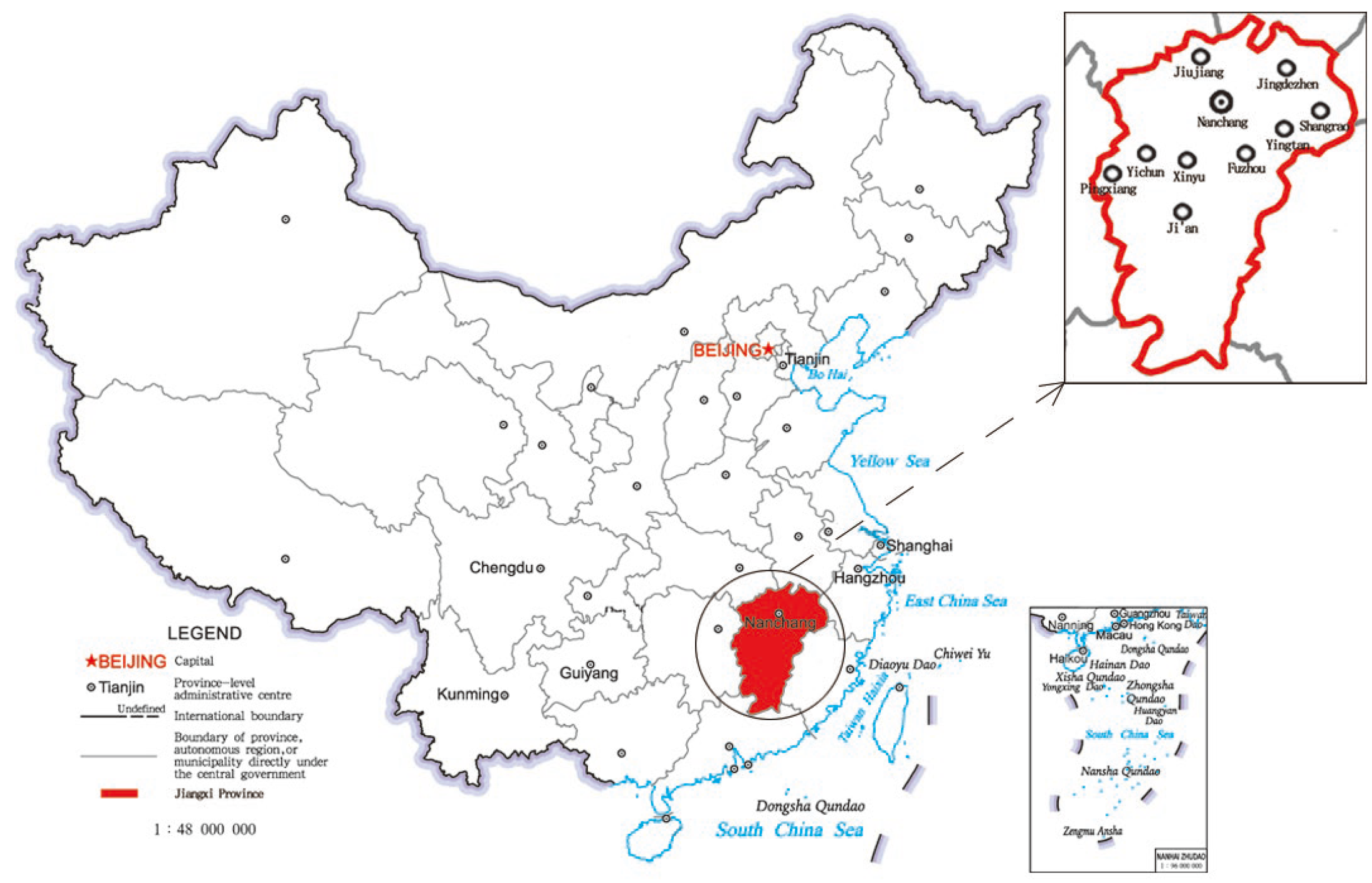
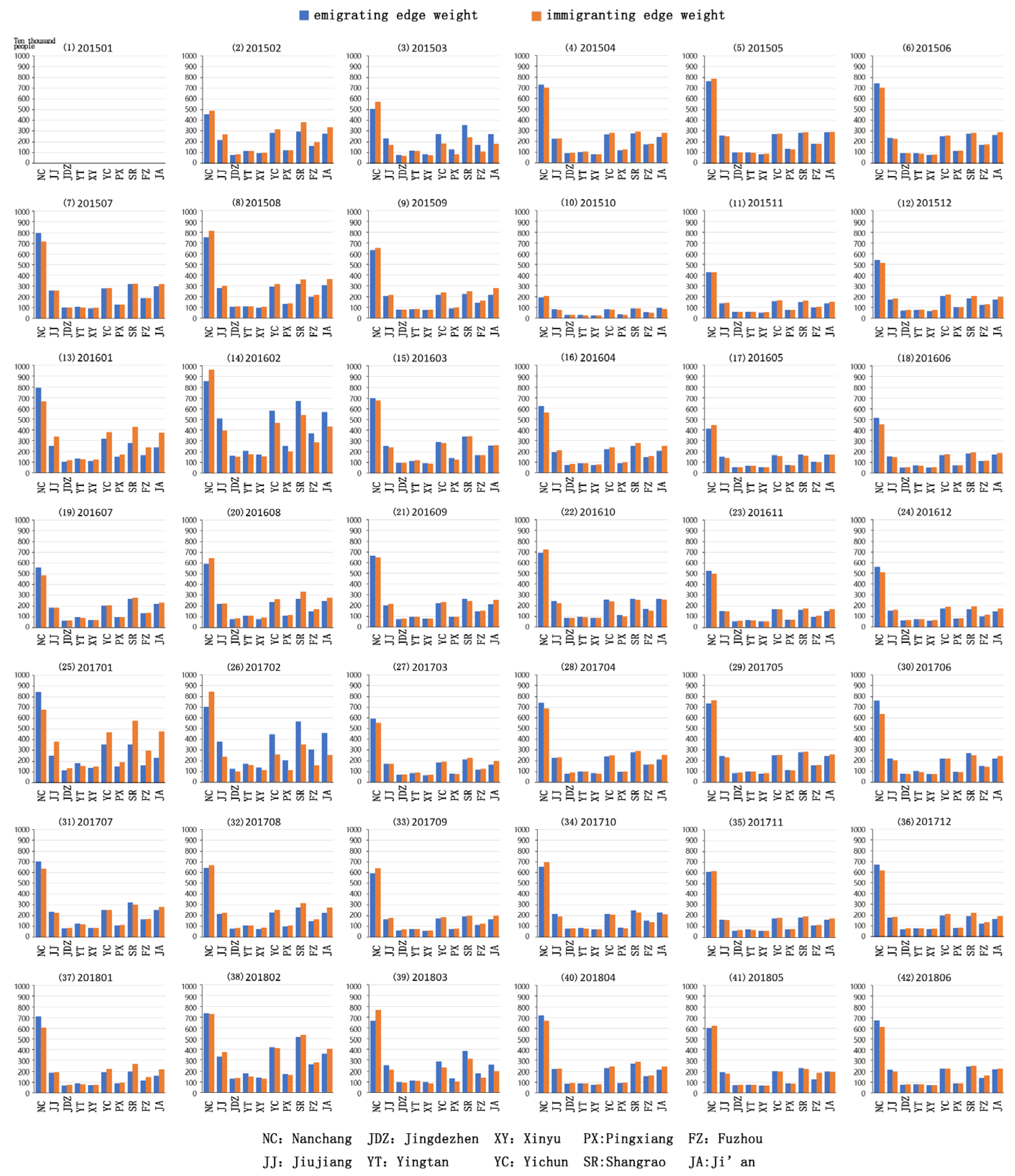
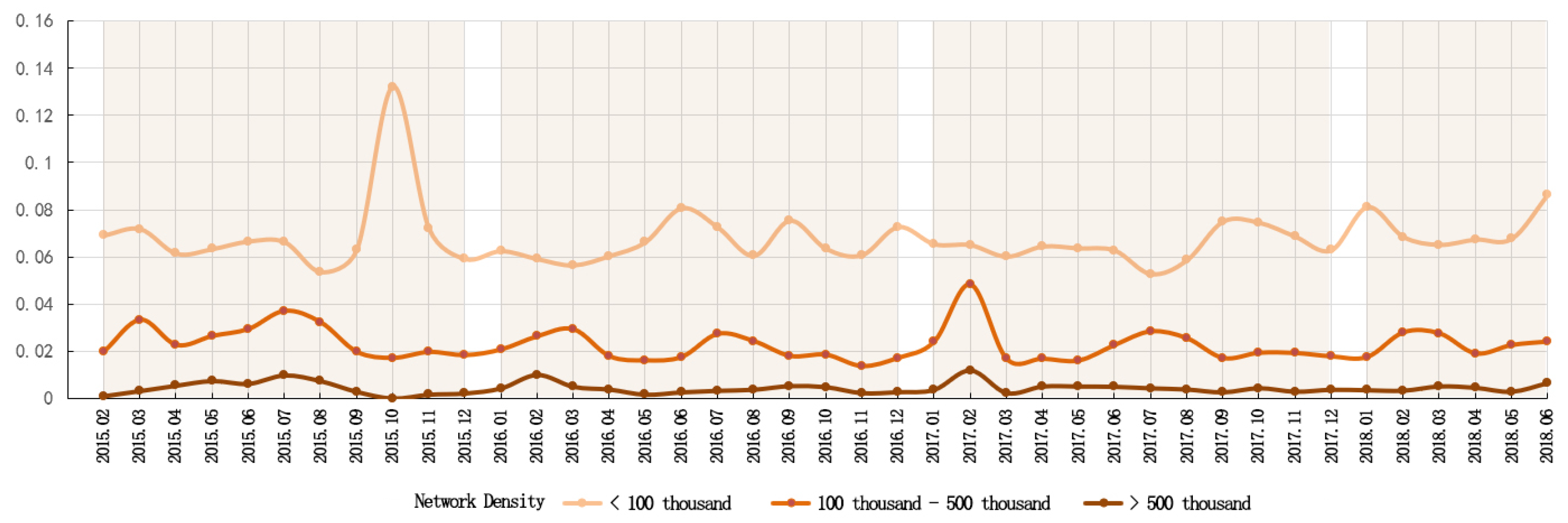
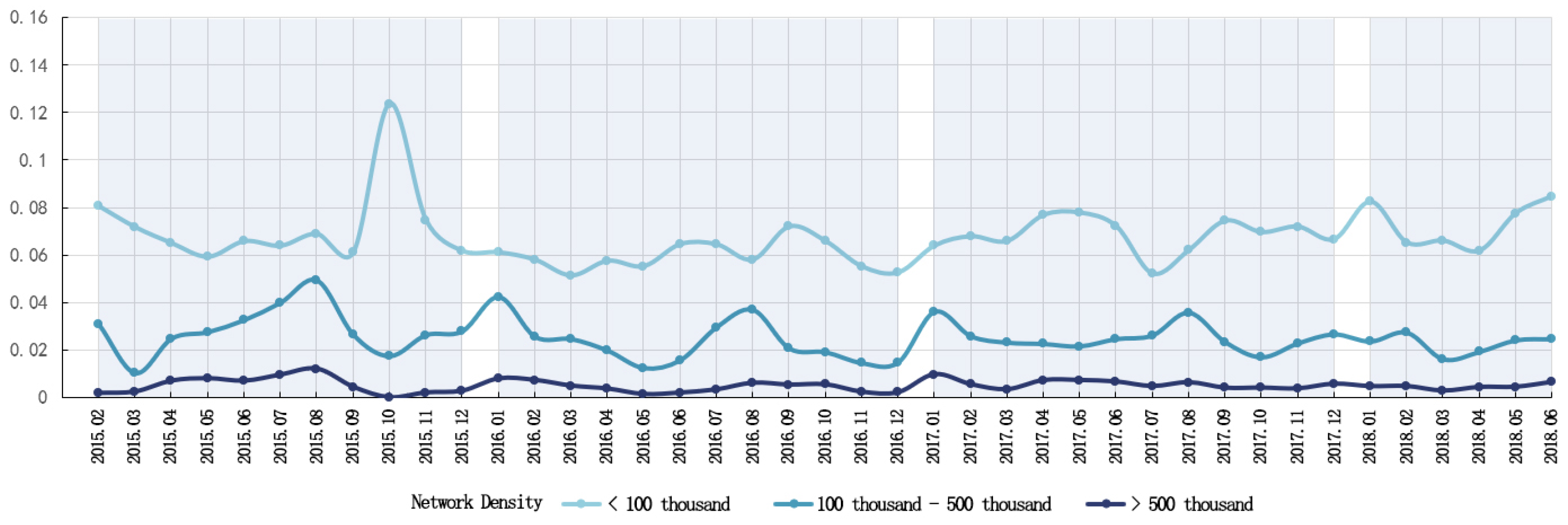

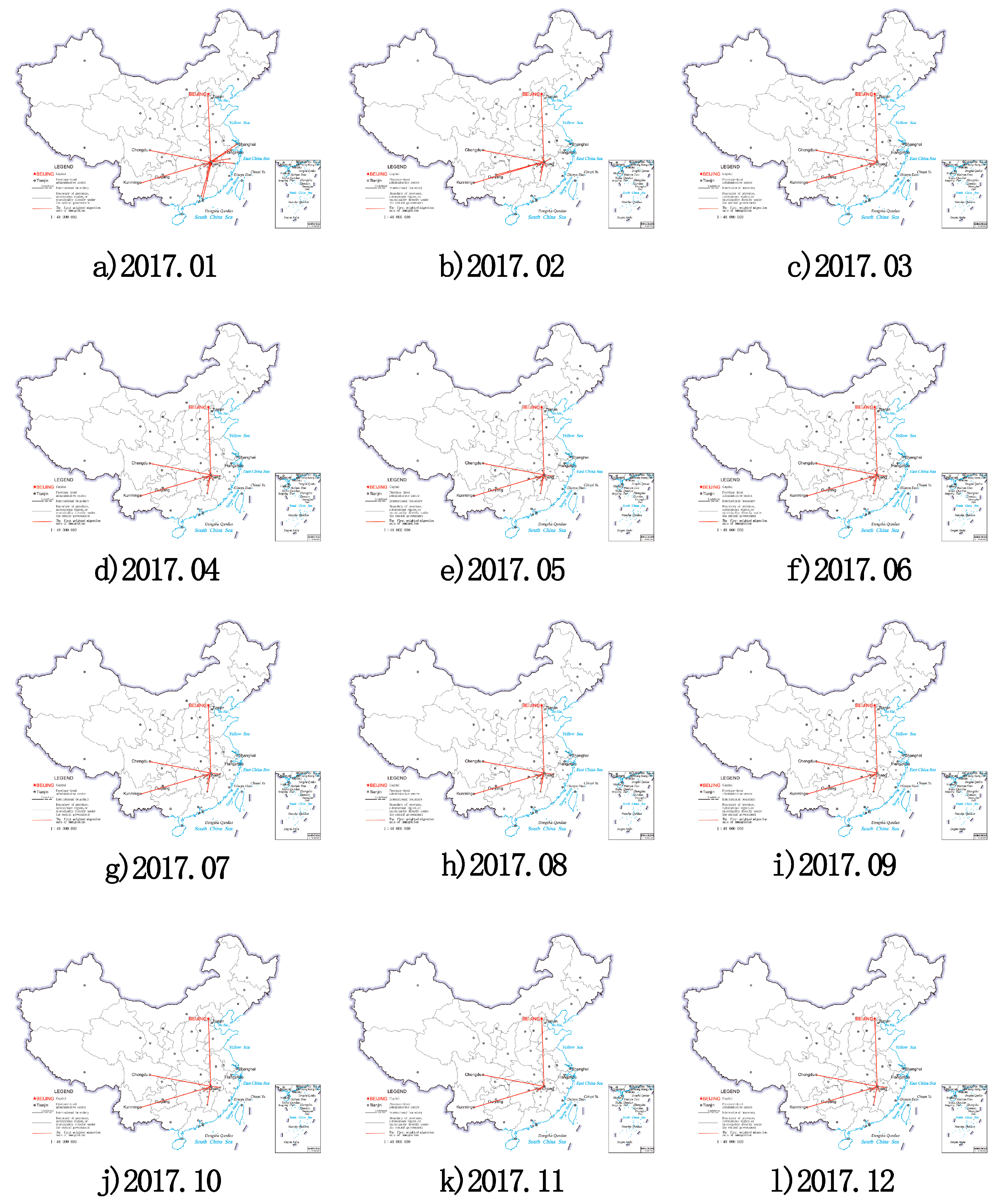
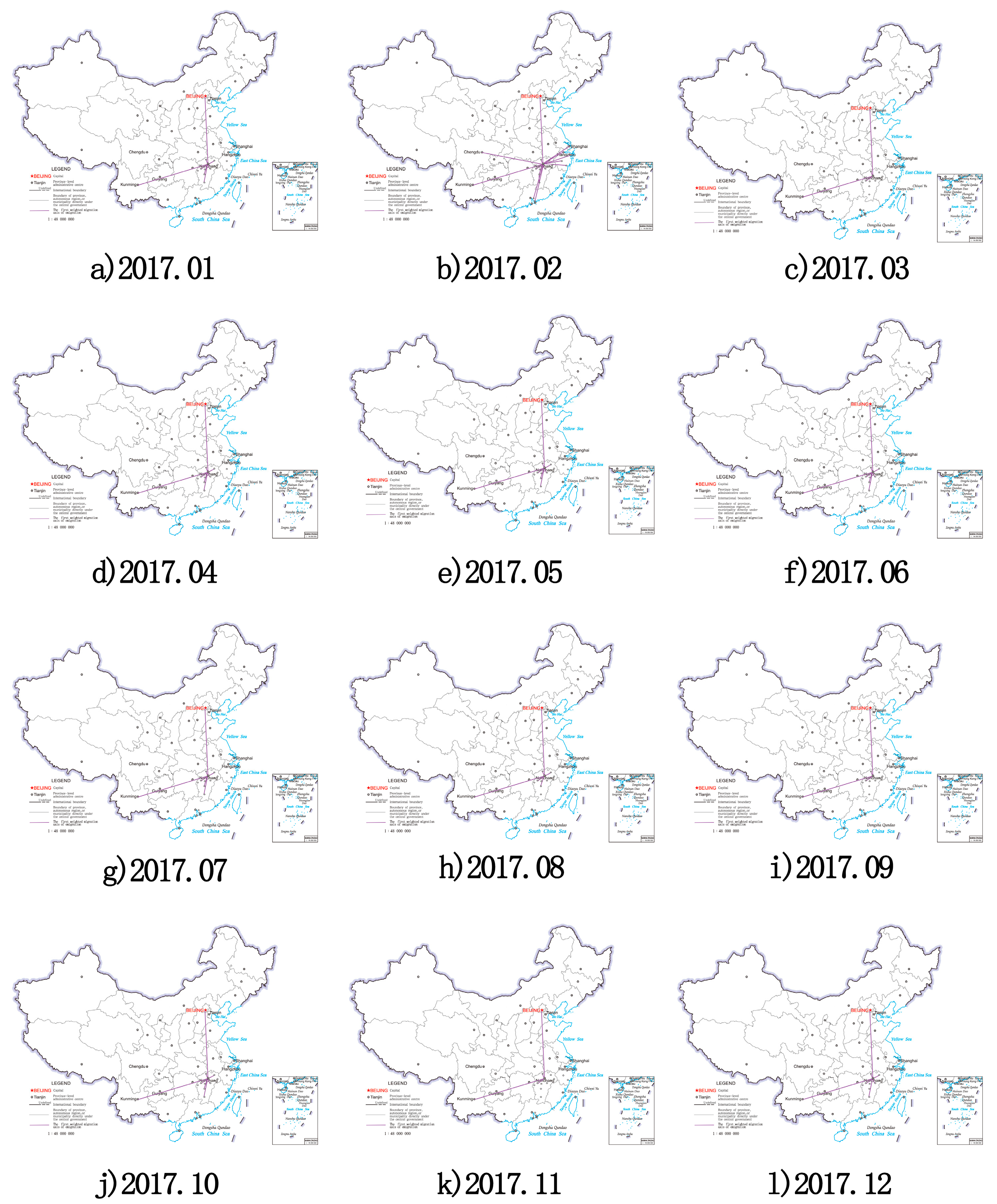
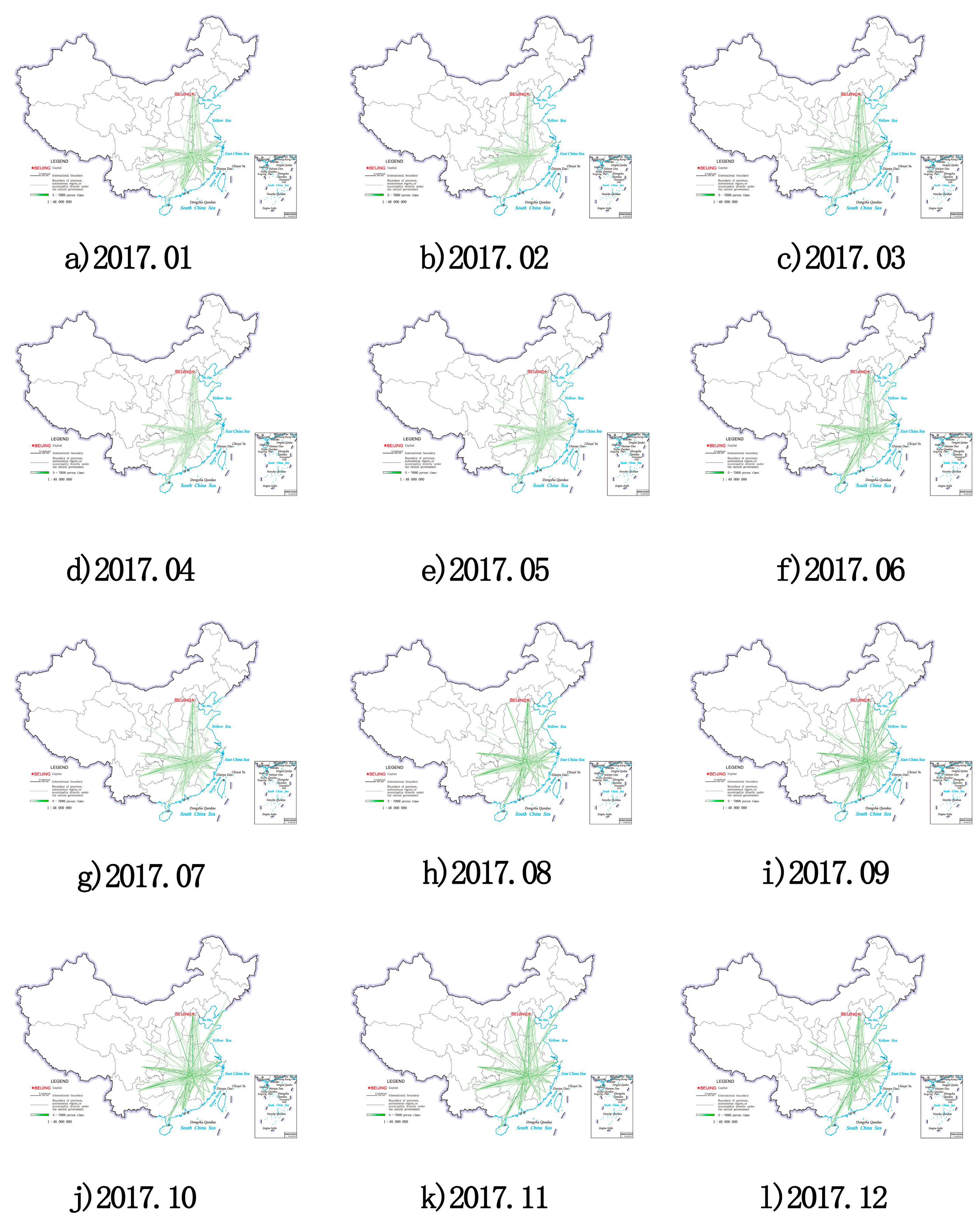
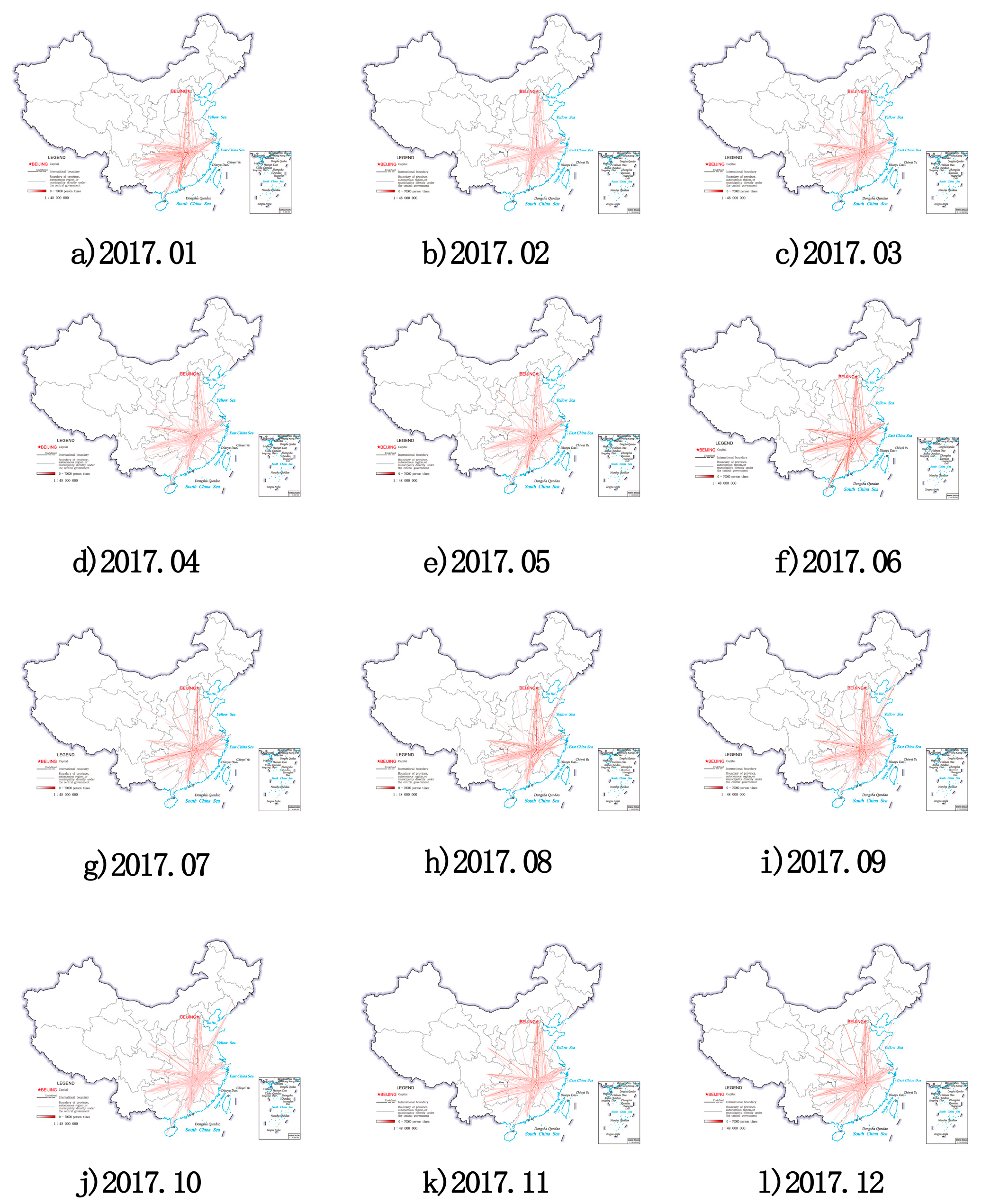
Disclaimer/Publisher’s Note: The statements, opinions and data contained in all publications are solely those of the individual author(s) and contributor(s) and not of MDPI and/or the editor(s). MDPI and/or the editor(s) disclaim responsibility for any injury to people or property resulting from any ideas, methods, instructions or products referred to in the content. |
© 2023 by the authors. Licensee MDPI, Basel, Switzerland. This article is an open access article distributed under the terms and conditions of the Creative Commons Attribution (CC BY) license (https://creativecommons.org/licenses/by/4.0/).
Share and Cite
Zhong, Y.; Chen, Y.; Qiu, J. Study on the Spatial Structure of the Complex Network of Population Migration in the Poyang Lake Urban Agglomeration. Sustainability 2023, 15, 14789. https://doi.org/10.3390/su152014789
Zhong Y, Chen Y, Qiu J. Study on the Spatial Structure of the Complex Network of Population Migration in the Poyang Lake Urban Agglomeration. Sustainability. 2023; 15(20):14789. https://doi.org/10.3390/su152014789
Chicago/Turabian StyleZhong, Yanfen, Yuqi Chen, and Jiawei Qiu. 2023. "Study on the Spatial Structure of the Complex Network of Population Migration in the Poyang Lake Urban Agglomeration" Sustainability 15, no. 20: 14789. https://doi.org/10.3390/su152014789
APA StyleZhong, Y., Chen, Y., & Qiu, J. (2023). Study on the Spatial Structure of the Complex Network of Population Migration in the Poyang Lake Urban Agglomeration. Sustainability, 15(20), 14789. https://doi.org/10.3390/su152014789




